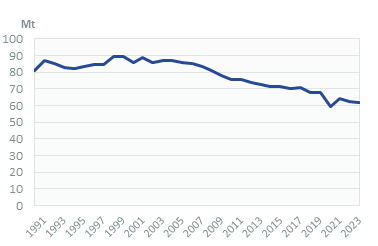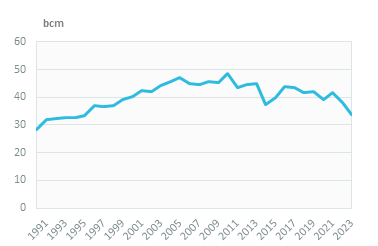-
-
 Energy and Climate Databases
Energy and Climate Databases- The most comprehensive and up-to-date annual energy database.
- Monitoring of technology providers in H2 supply chain.
- Monthly energy data on key energy markets.
- The most reliable and up-to-date power generation database.
- The essentials of LNG trade at your fingertips.
- Global monitoring of new and existing refineries.
- Analyse energy consumption and efficiency trends at world level. Benchmark countries.
- Have your database developed by a recognised expert of both energy and IT.
-
 Energy - Climate Forecasts
Energy - Climate Forecasts- Instant access to energy and emissions forecasts.
- Strategic, annual wholesale price projections backed by Enerdata's energy modelling expertise and our globally recognised POLES model.
- Wedges module showing a breakdown of the levers enabling to reduce emissions between two scenarios.
- Unique, independent projections of consumption by end-use.
- GHG Marginal Abatement Cost Curves.
- Benefit from proven models to draw your own energy scenarios and anticipate tomorrow’s challenges.
-
 Market Intelligence
Market Intelligence- 110 Energy and climate country reports
- A newsletter to receive the latest updates on evolving technologies and policies.
- Global energy news and analyses curated daily.
- Enerdata’s experts bring you the essentials about your market and competitors.
-
-
-
 Market Analysis
Market Analysis- Understanding key consumption trends and drivers across sectors.
- Granular and exclusive insight to address the most pressing business and strategic issues.
- Expertise in strategic and business intelligence, with fine-tuning to the market’s specificities.
-
 Energy - Climate Scenarios
Energy - Climate Scenarios- Providing the outlook of an energy commodity in mid to long term time horizons.
- Sector and driver specific energy demand forecasting.
- Assess the evolution of energy prices on the international and regional markets, as well as end-users prices.
- Enerdata guides you through pathways to reach climate targets.
- Supporting local authorities in their decarbonisation strategies.
-
 Climate Strategy and Policy Evaluation
Climate Strategy and Policy Evaluation- Cutting-edge quantitative tools and relevant indicators to monitor and evaluate evolutions on worldwide energy markets.
- Analysis of the most cost-effective options to reduce emissions.
- Quantified simulation and analysis of pledges for climate change negotiations.
- Breakdown of carbon markets and evaluation of the climate change impacts on the carbon price.
- Enerdata guides you on the most beneficial policy or investment options.
- Turning climate objectives into concrete action plans.
-
 Training
Training- Understand different policy targets and measures on energy efficiency.
- How to measure energy savings?
- Energy Forecasting is a 2 days training to learn to design and interpret energy forecasts.
- Energy statistics training allowing to create energy balance with supply, transformation and consumption and understanding the international energy statistics regulations.
- Initiation to EnerMED level 1is the training to approach on the most powerful energy demand forecasting model.
-
-
Resource Centre
France Key Figures
- Population:
- 68.1 million
- GDP growth rate:
- 0.87 %/year
- Energy independence:
- 55.4%
Data of the last year available: 2023
- Total consumption/GDP:*
- 64.9 (2005=100)
- CO2 Emissions:
- 3.91 tCO2/capita
- Rate of T&D power losses:
- 7.89%
* at purchasing power parity
View all macro and energy indicators in the France energy report
France Energy News
View all news, archive your new and create your own daily newsletters only on your topics/countries of interest with Key Energy Intelligence
France Energy Research
Benefit from up to 2 000 up-to-date data series for 186 countries in Global Energy & CO2 data
A data overview is available in the global energy statistics app
France Total Energy Consumption
Consumption per capita stood at 3.1 toe in 2023 and is around 12% above the EU average. Electricity consumption per capita is 13% higher than the EU average due to the high penetration of electric heating (6 000 kWh in 2023).
Graph: CONSUMPTION TRENDS BY ENERGY SOURCE (Mtoe)

Interactive Chart France Total Energy Consumption
Benefit from up to 2 000 up-to-date data series for 186 countries in Global Energy & CO2 data
View the detailed fondamentals of the market at country level (graphs, tables, analysis) in the France energy report
France Crude Oil Production
Since 2021, imports of crude oil have increased by 12%/year to 46 Mt in 2023, after a 32% fall in 2020. This increase is driven by a rise in the production of petroleum products, which grew by 14%/year between 2021 and 2023 to 47 Mt. As a consequence, imports of oil products are declining (-9%/year over 2021-2023).
France received crude oil from three ports: Donges (near Nantes), Le Havre and Marseille. Six additional import points of refined products are located in Bordeaux, Dunkerque, Frontignan, La Rochelle, Port La Nouvelle, and Strasbourg.
Interactive Chart France Crude Oil Production
Benefit from up to 2 000 up-to-date data series for 186 countries in Global Energy & CO2 data
Additionally, for more detailed information on refineries, you can request a sample of our EMEA Refineries Dataset
France Oil Products Consumption
Since its peak in 2001 at 89 Mt, oil product consumption decreased by 1.6%/year on average to 62 Mt in 2022 (-30% since 2001).
Graph: OIL CONSUMPTION (Mt)

The share of oil is focused on captive uses, namely the transport sector, with a 62% share of oil consumption, up from 53% in 2010.
Graph: OIL CONSUMPTION BREAKDOWN BY SECTOR (2023, %)

Interactive Chart France Refined Oil Products Production
Benefit from up to 2 000 up-to-date data series for 186 countries in Global Energy & CO2 data
Additionally, for more detailed information on refineries, you can request a sample of our EMEA Refineries Dataset
France Natural Gas Consumption
Since 2010, gas consumption declined by an average of 2%/year, including 11% in 2023 (-31% over 2010-2023).
Graph: NATURAL GAS CONSUMPTION (bcm)

Buildings accounts for 47% of gas consumption, followed by industry (31%) and power plants (16%).
Interactive Chart France Natural Gas Domestic Consumption
Benefit from up to 2 000 up-to-date data series for 186 countries in Global Energy & CO2 data
Additionally, for more detailed information on the LNG trade, you can request a sample of our EMEA LNG Trade Dataset
France Coal Consumption
Since 2013, coal consumption has decreased by 8%/year to 7.4 Mt (-48% over 2013-2023), including -21% in 2023, as a result of the shutdown of virtuarlly all French coal-fired power plants. Coal is mostly consumed in industry (45%) and other sectors (coking plants) (41%).
Graph: COAL CONSUMPTION (Mt)

Graph: COAL CONSUMPTION BREAKDOWN BY SECTOR (2023, %)
Interactive Chart France Coal and Lignite Domestic Consumption
Benefit from up to 2 000 up-to-date data series for 186 countries in Global Energy & CO2 data
View the detailed consumption trends at country level (graphs, tables, analysis) in the France energy report
France Power Consumption
After a peak at 472 TWh in 2010, electricity consumption has decreased by an average of 0.7%/year to 411 TWh in 2023, including 4% in 2023 (-10% since 2010).
Graph: ELECTRICITY CONSUMPTION (TWh)

Households absorb 37% of electricity consumption in 2023. Services are responsible for 31% of the consumption and industry for 25%.
Graph: ELECTRICITY CONSUMPTION BREAKDOWN BY SECTOR (2023, %)
France Renewable in % Electricity Production
The target set in the NECP (2021) for 2030 is a share of 33% of renewables in the final consumption.
The draft NECP (2023) targets 58% of decarbonised energy in the energy mix in 2030 and 71% in 2035, without specifying a goal in terms of renewables. The share of renewables in heating and cooling should reach 45% in 2030 (297 TWh) and 55% in 2035 (330-419 TWh), and France should produce 50 TWh of biogas and 48 TWh of biofuels.
Interactive Chart France Share of Renewables in Electricity Production (incl hydro)
Benefit from up to 2 000 up-to-date data series for 186 countries in Global Energy & CO2 data
Learn more about renewables in the European Battery Market Analysis
France CO2 Fuel Combustion/CO2 Emissions
GHG emissions, excluding LULUCF, fell by 5.8% in 2023 to 373 MtCO2eq, according to preliminary data from CITEPA. This represents a level about 26% below that of 1990.